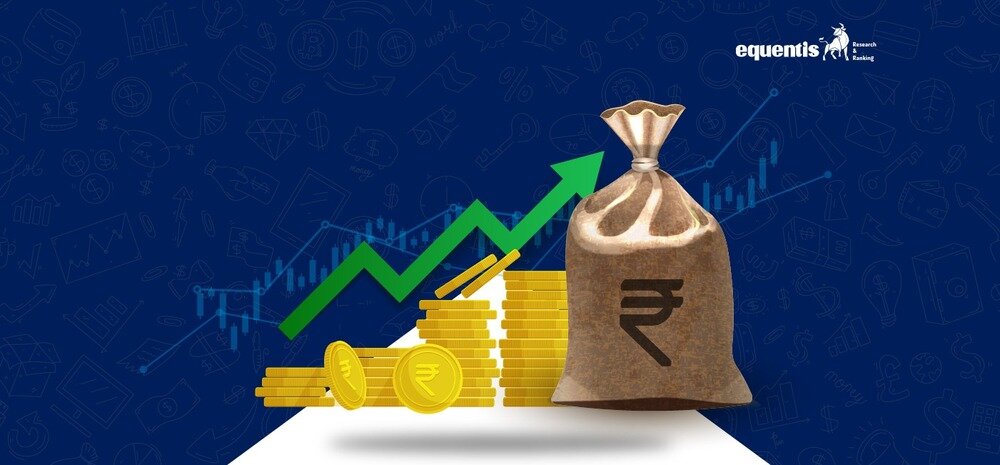The Interest Coverage Ratio is a critical metric that provides insight into a company’s ability to manage its debt obligations. Like PE Ratio, PB ratio, or debt-to-GDP ratio, this ratio is essential for investors, creditors, and financial analysts as it helps them assess the risk associated with lending to or investing in a firm. Let’s explore the interest coverage ratio’s meaning, types, interpretation, and importance.
What is Interest Coverage Ratio?
The interest coverage ratio is a financial ratio used to determine how easily a company can pay interest on its outstanding debt. It is calculated by dividing a company’s Earnings Before Interest and Taxes (EBIT) by its interest expense during a given period.
The interest coverage ratio formula is EBIT/Interest Expense
A higher interest coverage ratio suggests that a company can comfortably meet its interest obligations from its operating earnings, a sign of financial stability.
How the Ratio Reflects a Company’s Ability to Pay Interest on Its Debt
A higher interest coverage ratio indicates a strong financial position, where a company generates sufficient earnings to pay its interest expenses comfortably. Conversely, a lower ratio can signal financial distress, raising concerns about solvency.
Types of Interest Coverage Ratios
While the standard interest coverage ratio interpretation is centered around Earnings Before Interest and Taxes (EBIT), the financial landscape offers a spectrum of interest coverage ratio types, each incorporating different financial metrics to provide a nuanced view of a company’s interest-paying capacity. Let’s expand on these variations:
- EBITDA Interest Coverage Ratio: The EBITDA Interest Coverage Ratio broadens the scope by including Earnings Before Interest, Taxes, Depreciation, and Amortization (EBITDA). This variant of the interest coverage ratio is particularly insightful for companies with significant non-cash expenses like depreciation and amortization. By excluding these expenses, the EBITDA interest coverage ratio can offer a clearer picture of a company’s operating profitability and ability to cover interest expenses from its operational cash flow.
- Fixed Charge Coverage Ratio (FCCR): Moving beyond interest expenses, the Fixed Charge Coverage Ratio (FCCR) includes all of a company’s fixed financial obligations. This includes lease payments and other fixed charges in addition to interest expenses. The FCCR is a stringent test of a company’s financial strength, as it assesses the firm’s ability to cover all recurring fixed charges, not just interest, which is crucial for businesses with substantial lease commitments or other fixed contractual payments.
- EBITDA Less CapEx Interest Coverage Ratio: The EBITDA Less Capex Interest Coverage Ratio considers a company’s capital expenditures (CapEx). CapEx indicates the company’s funds to acquire, upgrade, and maintain physical assets such as property, plants, buildings, technology, or equipment. It represents the amount a company invests in existing and new fixed assets to maintain or grow its business. By deducting Capex from EBITDA, this ratio provides a more conservative estimate of a company’s available cash flow for servicing interest expenses. It’s a vital metric for capital-intensive industries where regular, large-scale asset investments are necessary for continued operations.
- EBIAT Interest Coverage Ratio: The EBIAT Interest Coverage Ratio offers an after-tax perspective using Earnings Before Interest After Taxes (EBIAT). This ratio is beneficial for understanding the impact of taxation on a company’s ability to pay interest. Since taxes can significantly affect a company’s net income, the EBIAT interest coverage ratio gives stakeholders a more realistic view of the firm’s interest coverage capabilities post-taxation.
Interpreting the Interest Coverage Ratio
The interpretation of the interest coverage ratio can vary. Still, generally:
An interest coverage ratio of 1 or less suggests that a company struggles to meet its interest obligations and may be at risk of default.
An interest coverage ratio of 1.5 to 2 indicates that a company is on solid financial ground with sufficient earnings to cover its interest expenses.
It’s important to note that the ideal interest coverage ratio can vary by industry due to different capital structures and operating risks. But in general, the higher the interest coverage ratio, the better. Let us take an example to understand it better.
Let’s say company XYZ has Earnings Before Interest and Taxes (EBIT) of Rs. 5,000,000 and interest expenses of Rs.1,000,000 for the year. The interest coverage ratio would be calculated as follows:
Interest Coverage Ratio = Earnings Before Interest and Taxes (EBIT) / Interest Expenses
Interest Coverage Ratio= 5,000,000/1,000,000 = 5
This ratio indicates that Company XYZ has an interest coverage ratio of 5, which means it earns enough to cover its interest expenses five times over. This is a strong sign of financial health and suggests the company is not at risk of default.
Interruption: During the same fiscal year, Company XYZ faced an unexpected event that caused its EBIT to drop to Rs. 2,000,000. The new interest coverage ratio would be:
Interest Coverage Ratio= 2,000,000 / 1,000,000 = 2
With the new interest coverage ratio of 2, the company still maintains an excellent position to cover its interest expenses, but it’s a significant decrease from the previous ratio of 5. This could signal to investors and creditors that while the company is still on solid ground, it’s more susceptible to financial stress than before.
Importance of the Interest Coverage Ratio
Here are the key points about the Interest Coverage Ratio:
- Vital Solvency Indicator: It’s crucial for assessing a company’s ability to pay interest on its debt.
- Financial Health Snapshot: A quick look at how effectively a company can service its debt.
- Long-term Viability: Essential for evaluating the sustainability of a company’s operations.
- Strong Ratio: Indicates significant financial flexibility for the company.
- Economic Resilience: Suggests the capacity to endure economic challenges.
- Investment Potential: Reflects the ability to capitalize on growth opportunities.
In conclusion, the Interest Coverage Ratio is essential for analyzing a company’s financial strength. By understanding its meaning, types, and interpretation, stakeholders can make more informed decisions regarding their investments and the company’s creditworthiness. But before investing in any such company, it is always suggested that one should consider investment advisory services, as they’ll guide you to make the right decisions and provide you with stock recommendations.
How to Calculate Interest Coverage Ratio?
1. Formula: EBIT / Interest Expense
The formula is Interest Coverage Ratio = EBIT / Interest Expense
2. Breaking Down the Components:
- EBIT (Earnings Before Interest and Taxes): Represents the company’s profitability before accounting for financing and taxation.
- Interest Expense: Reflects the cost of servicing the company’s debt.
3. Step-by-Step Example of Interest Coverage Ratio Calculation:
Let’s consider a hypothetical company, XYZ:
- EBIT: Rs. 5,000,000
- Interest Expense: Rs. 1,000,000
The calculation: Interest Coverage Ratio = 5,000,000 / 1,000,000 = 5
This indicates that Company XYZ can cover its interest expenses five times over, showcasing strong financial health.
Also Read: Top Financial Ratios Every Investor Should Know
What is a Good Interest Coverage Ratio?
1. Understanding the Benchmarks for Different Industries
The ideal interest coverage ratio varies across industries. For example:
- Capital-intensive industries may have lower benchmarks due to high fixed costs.
- Service-based industries generally maintain higher ratios due to lower debt levels.
2. Ideal Interest Coverage Ratio: What Does It Indicate?
An ideal interest coverage ratio is typically above 3. This suggests that the company generates ample earnings to cover its interest expenses comfortably.
3. When a Low Ratio is a Red Flag for Investors
An interest coverage ratio below 1 indicates that the company’s earnings are insufficient to meet its interest obligations, posing a risk of default.
Interest Coverage Ratio Example
1. Real-World Calculation Using a Hypothetical Company
Consider Company ABC:
- EBIT: Rs. 3,000,000
- Interest Expense: Rs. 600,000
Interest Coverage Ratio = 3,000,000 / 600,000 = 5
This indicates that ABC earns five times the amount needed to cover its interest payments.
2. Analysis of the Results: What the Ratio Reveals About Financial Health
A ratio of 5 suggests that the company is financially stable and can comfortably manage its debt obligations. However, a significant drop in EBIT could weaken this position.
Common Mistakes in Analyzing Interest Coverage Ratio
1. Ignoring Industry-Specific Variations in Benchmarks
Different industries have varying standards for what constitutes a good ratio. Comparing across unrelated sectors can lead to inaccurate conclusions.
2. Misinterpreting Temporary Declines in the Ratio
Short-term fluctuations in EBIT or interest expenses may not accurately reflect a company’s long-term financial health.
3. Failing to Combine With Other Financial Metrics
Relying solely on the interest coverage ratio without considering other financial indicators can provide an incomplete picture of a company’s performance.
FAQs on Interest Coverage Ratio
Is a higher interest coverage ratio better?
Yes, a higher Interest Coverage Ratio is generally considered better. It indicates that a company has more than enough earnings to cover its interest expenses, which suggests good financial health and lower credit risk. A high-interest coverage ratio means the company can quickly meet Its debt obligations without straining its resources.
What is the importance of the term interest coverage ratio?
The term “Interest Coverage Ratio” is important because it measures a company’s ability to pay the interest on its debt with its current earnings. This is crucial for lenders and investors as it helps them assess the risk of default. A strong interest coverage ratio indicates that a company is less likely to face financial distress, making it a more reliable investment or credit prospect.
How do you calculate the coverage ratio?
The Interest Coverage Ratio is calculated using the Interest Coverage Ratio formula: Interest Coverage Ratio= EBIT/Interest Expense To calculate it, you take the company’s Earnings Before Interest and Taxes (EBIT) for a given period and divide it by the interest expense incurred during the same period. The result tells you how often the company can cover its interest payments with its operational earnings.
How useful was this post?
Click on a star to rate it!
Average rating 3.7 / 5. Vote count: 3
No votes so far! Be the first to rate this post.
I’m Archana R. Chettiar, an experienced content creator with
an affinity for writing on personal finance and other financial content. I
love to write on equity investing, retirement, managing money, and more.
- Archana Chettiar













